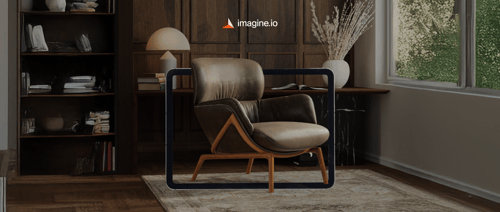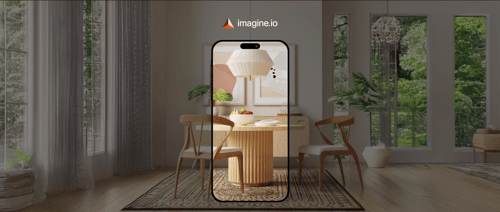Is your brand ready to scale high-impact visuals without sacrificing quality or authenticity? If you're leading creative, marketing, or digital operations at a home goods or lifestyle brand, this question is likely top of mind.
In 2025, how we create and consume product visuals is undergoing a major shift. The polished still image is no longer enough. Customers now expect immersive, real-time, and emotionally compelling visual experiences.
We're in a hybrid era of content creation—where traditional photography, CGI, AR, and AI converge to build flexible, scalable, and deeply engaging visual ecosystems. For companies leveraging platforms like imagine.io, this evolution isn’t just a trend—it’s a strategic edge. Here’s what’s shaping the visual future of home décor, and how to make it work for your brand.
Get the latest updates straight to your inbox.
By clicking sign up you'll receive occasional emails from imagine.io. You always have the choice to unsubscribe within every email you receive.
Authentic Photography: From Perfect to Personal
Highly polished product shots are losing traction. Today’s buyers connect with scenes that feel real and lived-in. Think natural lighting, cozy clutter, and emotional storytelling. To deliver that sense of relatability, consider showcasing products in casual, naturalistic settings with a focus on authenticity.
Simple details—a wrinkled blanket, a half-read book, or a warm glow from a nearby lamp—add humanity and comfort to your visuals. Even without a physical photoshoot, these intimate lifestyle moments can be built virtually using advanced styling capabilities.
Human-Centric Visuals: Diversity, Inclusion, and Emotion
Consumers want to see people who reflect their own lives. Including diverse models and relatable life moments strengthens emotional connection and brand relevance. Integrating a wide range of demographics into lifestyle visuals not only supports inclusion—it also shows how products live in the world.
A product staged during a family meal, a solo morning coffee, or a quiet reading nook doesn’t just demonstrate features—it tells a story. When you can quickly adapt scenes to reflect different life stages, household types, or cultural nuances, your visuals remain universally resonant.
Bold Composition & Color-Driven Imagery
Neutrals still have a role, but expressive color and bold framing are gaining momentum. They make visuals stand out, energize product presentation, and capture attention in saturated digital feeds.
This is where creative freedom becomes key. You might experiment with jewel-toned backgrounds, asymmetrical layouts, or exaggerated shadows—styles that feel editorial and polished. With the ability to test and adjust compositions dynamically, your team can strike the right visual tone for every product line or campaign.
Sensory-Driven Close-Ups
In an online-first retail world, visuals need to make up for the lack of touch. Detailed close-ups that emphasize materiality help customers imagine what it feels like to sit on that sofa, hold that mug, or walk barefoot across that rug.
Tactile storytelling—zooming in on stitching, wood grain, or texture transitions—builds trust and closes the sensory gap. When you can also adjust finishes or surfaces (like switching from matte to gloss), your product visuals stay accurate, versatile, and emotionally engaging.
360° & AR Visualization: Empower the Shopper

Today’s buyer expects control. Being able to rotate a product, view it in augmented reality, or place it within their space before buying is no longer a luxury—it’s a conversion-driving essential.
Implementing 360° spinners or “View in My Room” tools helps shoppers make informed decisions. They stay longer on product pages, explore more confidently, and are more likely to convert. And when your 3D product files are AR-ready out of the box, there’s no added production delay—just streamlined visual interactivity.
The Rise of CGI: Realism Meets Agility
CGI is now nearly indistinguishable from traditional photography, with far fewer limitations. Instead of relying on physical studios or scheduling seasonal shoots, brands can produce photorealistic imagery that’s endlessly flexible.
A single sofa render can be adapted for different markets, seasons, or lifestyle scenes. One digital room can be re-styled for a minimalist city loft or a cozy cabin in seconds. CGI allows your visual assets to become creative templates—evolving with your campaigns, not against them.
AI-Powered Image Generation & Enhancement
AI is speeding up how brands ideate, iterate, and localize content. With just a few inputs, it’s now possible to build lifestyle backdrops, add seasonal details, or adapt content for regional trends.
Used wisely, AI can help fill content gaps, prototype visual themes, or expand visual libraries without additional photoshoots. It’s important, of course, to review outputs with a critical eye—lighting, proportion, and material realism still need human oversight. But when paired with 3D styling systems, AI becomes a true accelerator.
Motion Content: Because Static Isn’t Enough

Visuals in motion tell richer stories. Whether it’s a 3D product spin, a cinemagraph of a flickering candle, or a 15-second video of a table being styled for dinner—motion builds connection.
Short-form video and animated visuals allow customers to see how a product moves, functions, or fits into daily life. And when you can produce those assets directly from existing 3D scenes, your brand can deliver engaging motion content without adding complexity.
Conclusion
The future of home decor visualization lies in adaptability, immersion, and efficiency. Today’s top brands aren’t just showcasing products—they’re crafting emotional, tech-enabled narratives across every customer touchpoint.
At imagine.io, we help brands like yours scale high-quality content with precision, speed, and creative flexibility. Ready to transform your product visuals into a strategic advantage? Book a demo and see how imagine.io can help you out.


.gif?width=1296&height=1296&name=Untitled%20design%20(8).gif)




.png?width=500&name=How%20to%20Add%20a%203D%20Product%20Configurator%20to%20Your%20WordPress%20Website%20(Complete%20B2B%20Guide).png)
















%20(1).png?width=500&name=Why%20Exploded%20Mattress%20Views%20Matter%20(And%20How%20to%20Generate%20Them)%20(1).png)
.png?width=500&name=Best%20Shopify%20Product%20Configurator_%20How%20to%20Choose%20the%20Right%20One%20(2).png)
.png?width=500&name=Why%20Exploded%20Mattress%20Views%20Matter%20(And%20How%20to%20Generate%20Them).png)



.png?width=500&name=Best%20Shopify%20Product%20Configurator_%20How%20to%20Choose%20the%20Right%20One%20(1).png)







.png?width=500&name=How%203D%20Rendering%20Can%20Make%20or%20Break%20Your%20Industrial%20Design%20Pitch%20(1).png)








%20with%20Digital%20Twins%20and%203D%20Visualization.png?width=500&name=Optimizing%20Your%20Digital%20Asset%20Management%20(DAM)%20with%20Digital%20Twins%20and%203D%20Visualization.png)




.png?width=500&name=Styling%20Home%20Decor%20for%202025_%20From%20Global%20Influences%20to%20Playful%20Personalization%20(1).png)
